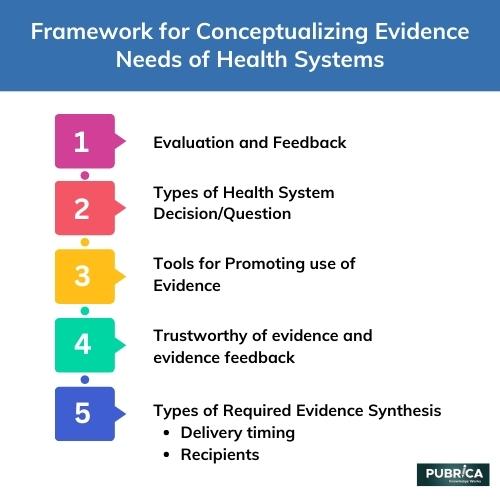A Framework for Conceptualizing Evidence Needs of Health Systems
According to the findings of the literature study, health systems seek information to support decisions regarding acquiring new or developing medical technology, implementing or expanding service offerings, and selecting governance, financing, or delivery system models. Studies show a preference for evidence syntheses that are performed quickly, succinctly, and simply comprehended with tiered information displays. Data from the open-access journal evidence synthesis programs show that health systems handle a wide range of topics and report kinds. The importance of the trustworthiness of the process for synthesizing published literature, the trustworthiness of the evidence itself, mechanisms for integrating internally generated data with evidence from published literature, and evaluation, feedback, and updating mechanisms facilitated by transforming published literature into executable machine knowledge for use by decisionmakers was highlighted in discussions with health system experts.
A framework for conceptualizing the evidence needs of health systems can help stakeholders identify and prioritize the types of evidence required to improve health system performance. Here are five key elements that can form the basis of such a framework:

1. Health system goals: The first step is identifying the health system's goals. These goals may include improving health outcomes, reducing health inequalities, increasing access to care, or enhancing the efficiency of the health system.
2. Evidence domains: The next step is to identify the evidence domains relevant to the health system goals. These may include clinical literature review evidence, health services research, health economics, social determinants of health, and policy analysis.
3. Evidence sources: The third step is to identify the sources of evidence that can provide the required evidence domains. These sources may include randomized controlled trials, observational studies, qualitative research, program evaluations, and administrative data.
4. Evidence gaps: The fourth step is to identify the gaps in the available evidence needed to achieve the health system goals. These gaps may be related to the available evidence's quantity, quality, or relevance.
5. Evidence use: The final step is to identify how the evidence will be used to inform decision-making and improve health system performance. This may involve developing clinical guidelines, informing policy decisions, or implementing best practices.
By considering these five elements, stakeholders can develop a comprehensive framework for conceptualizing the evidence needs of health systems. This framework can be used to guide the selection and prioritization of research studies, inform the development of evidence-based policies and guidelines, and support the implementation of best practices in health systems.
Conclusion
Pubrica provides several domains to facilitate interaction between health systems and evidence synthesis producers. Successful engagement will require specifying the type of decision or question of the health system; the type of evidence synthesis to best address the question(s) of interest; tools to promote the use of evidence; and a feedback or auditing mechanism to determine the impact of evidence integration into health system decisions. Both the trustworthiness of the evidence synthesis process and communication of the trustworthiness of the evidence are additional key domains. Partnerships with health systems are critical for understanding their evidence needs and establishing trust.
Give yourself the Medical edge today
Each order includes
- On-time delivery or your money back
- A fully qualified writer in your subject
- In-depth proofreading by our Quality Control Team
- 100% confidentiality, the work is never re-sold or published
- Standard 7-day amendment period
- A paper written to the standard ordered
- A detailed plagiarism report
- A comprehensive quality report

